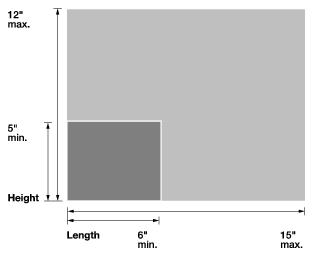|
|
|
Quick Service Guide 301aCommercial FlatsDesigning Flats for Automated ProcessingMay, 11 2009 Related QSGs 301, Physical Standards for Discount Flats 330b, First-Class Mail Automation Flats 340b, Standard Mail Automation Flats 360, Bound Printed Matter Flats 707g, Periodicals Barcoded (Automation) Flats Overview Flat-size pieces meeting the applicable automation standards in 301.3.0 are entitled to automation or Periodicals machinable prices. Size, weight, thickness, polywrap, and flexibility standards vary for the class of mail. For eligibility and preparation standards for specific price options, see the appropriate Quick Service Guide above. Physical Standards (301.3.0) Shape: rectangular, with four square corners, or with finished corners that do not exceed a radius of 0.125 inch (1/8 inch). Dimensions: The length of a flat-size mailpiece is the longest dimension. The height is the dimension perpendicular to the length (301.1.2). Maximum weight:
Uniform thickness: The contents must be uniformly thick so that any bumps, protrusions, or irregularities do not cause more than 1/4 inch variance in thickness. The mailpiece must have a smooth and regular shape and be free of creases, folds, tears, or other irregularities (301.3.7). Flexibility and deflection: automation flats must meet the flexibility standards in 301.1.3 and deflection standards in 301.3.2.3. Polywrap films and similar coverings must meet the standards in 301.3.4. A list of approved polywrap and polywrap manufacturers is available on ribbs.usps.gov. The wrap direction must be around the longer axis of the mailpiece, with the seam parallel to that axis. The longer axis is always parallel to the length of the mailpiece. The preferred seam placement is on the nonaddressed side of the mailpiece. Prohibitions: Clasps, strings, buttons, or other protrusions; also staples, unless properly used as a binding method (301.3.7). Delivery Address (302.1.0) Flats must have the address of the intended recipient, visible and legible, only on the side of the piece bearing postage. (Periodicals do not display postage and the address may appear on either side.) Use at least 8-point type for addresses on flats prepared without delivery point barcodes. A sans-serif font printed in all capital letters is preferred. The individual characters in the address cannot overlap. The individual lines in the address cannot touch or overlap. A minimum 0.028-inch clear space between lines is preferred. Mailers preparing flats with POSTNET or Intelligent Mail barcode delivery point routing codes may print addresses in all capital letters and a minimum of 6-point type. Address Placement (302.2.0) On all Periodicals, Standard Mail, Bound Printed Matter, Media Mail, and Library Mail flats mailed at presorted, automation, or carrier route prices, mailers must place the delivery address parallel or perpendicular to the top edge on the front or the back of the mailpiece and within the top half of the mailpiece. If there is a bound or folded edge, the address as read must be within the top half when the bound or folded edge is to the right. It cannot be upside down as read in relation to the top edge. If the address is placed on a mailing wrapper, the address must be on a flat side, not on a fold. If a polybag is used, the address must not appear on a component that rotates within the bag and must remain visible throughout the addressed component's range of motion. See 707.3.3.10 for addresses prepared on Periodicals label carriers. Barcodes (302.5.0) Barcodes must be at least 1/8 inch from any edge of the address side. Address block barcodes must be in one of these four positions: The surface the barcode is printed on must meet the reflectance standards in 708.4.4. The minimum clearance between the barcode and any information line above or below it within the address block must be at least 0.040 (1/25) inch for POSTNET barcode or 0.028 inch for an Intelligent Mail barcode. The separation between the barcode and the top line or bottom line of the address block must not exceed 0.625 (5/8) inch. The clearance between the leftmost and rightmost bars and any printing must be at least 0.125 (1/8 inch). Window Envelope Barcode Placement:
For envelope window, a clear space must be maintained when insert is moved to its full limits in each direction within envelope (202.5.0). Address Label Barcode Placement:
|
